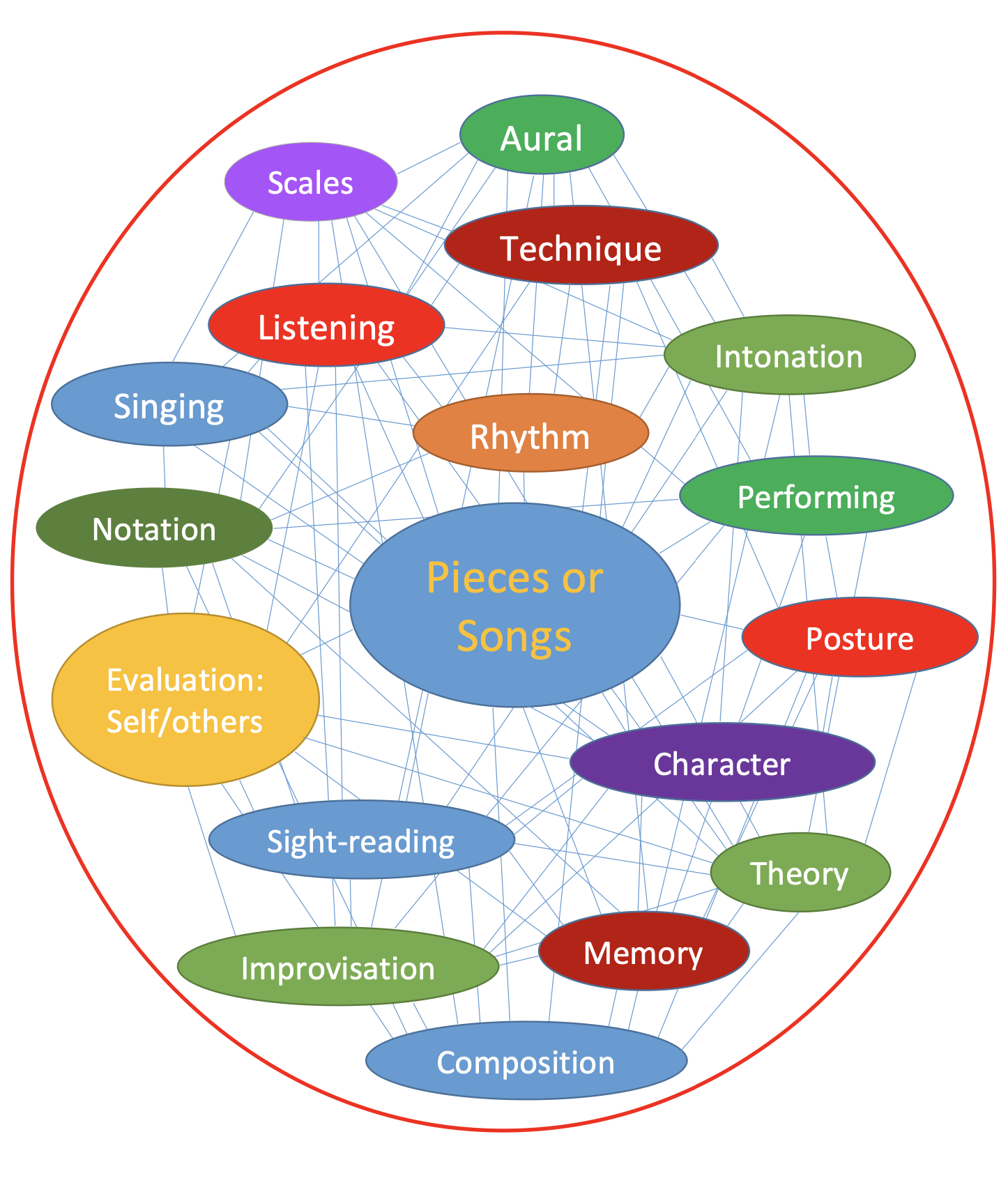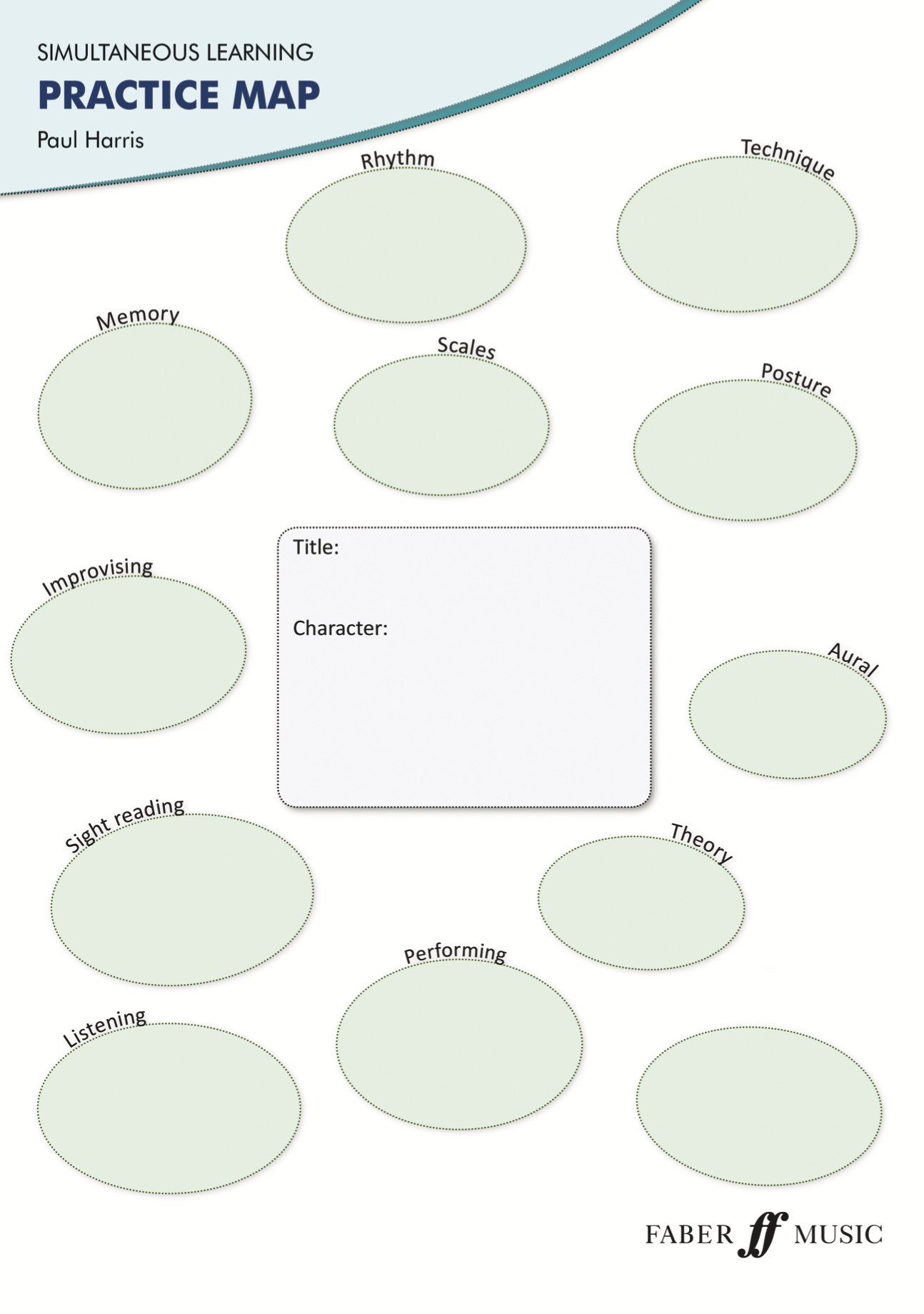The Musical Map of the World
The Simultaneous Learning Map is a map of our world. More particularly, a map of our musical world! It is a collection of all (or at least most) of the areas that go to make up music. Professional musicians and teachers know this map instinctively – it’s where we live. Most of our pupils don’t… our job is to help them know it too.
Lessons are therefore very much a voyage of discovery around this map. We effortlessly flow from one area to another as a lesson unfolds and at each short stop at an appropriate area, we devise a connected activity. Maybe beginning with a scale (of the piece or song we are teaching) and then we connect with some technique, then notation and then aural and so on, building up a series of sequential and logical activities. This is at the heart of Simultaneous Learning. There is no best route – the next destination is dependent on our pupil’s responses and what we think will enhance and develop the learning most effectively. Having this map on our desk as we teach, and encouraging pupils to have one on theirs when they practice, will help to make the learning journey more imaginative, interesting, thoughtful and musical.
For pupils it will help them to manage their learning much more effectively. Especially when they are practicing. What to do next is such an important question. Just playing or singing through pieces or songs is not practice. Instead they learn to create a sequence of well related activities with the aid of this map – and it will bring about real engagement and involvement. Practice will become so much more enjoyable!
Practice Map
Everything connects!
And that’s the way our brains work best too.
These Maps can be filled in by the teacher during the lesson … or, better still, by the student. Use them as often as you like… eventually they will develop a really imaginative and effective approach to practice.
So… here’s what to do:
Take a piece or song to be practised and write its title in the central box - then below the title add a few words to describe what you think the main character of the piece of song is about. Next set about filling in the significant features in the appropriate bubbles: the scale, important rhythms, other markings and so on. Then start making up activities that explore these connections and enjoy some really effective practice! Work at the scale (perhaps using the rhythms) improvise a little piece in the key (using the rhythms and making a further connection to the markings in the music. Perhaps try a relevant sight-reading piece (or part of a piece) think about the intervals (some theory), hear them in your head (aural) and so on….
You can see all this on your Practice Map, and also how they all interconnect. There is no order for these activities by the way… just let one lead you happily and instinctively on to the next. Draw in lines to show the link from the box to the bubbles, and on to further bubbles as you make further connections. There is one unmarked bubble (at the bottom right of the diagram) which could be the key, or key-note, other markings, some aspect of interpretation or anything else you’d like it to be!
There’s a Practice Map filled out to give an idea how it might look. This could be practice after the first lesson on ‘A Walking Tune’, a little piece for beginner pianists.
Happy practising!
Download Practice Map
Paul Harris discusses his highly imaginative approach to music teaching known as Simultaneous Learning
Teaching music should be a positive, stimulating, imaginative and effective process. Do you agree? Of course you do! But many teachers find themselves buried deep in the bleak and negative world of reacting to pupils’ mistakes or poor work, whilst trying to meet unrealistic parental expectations or exam or concert deadlines. Generally teachers teach as they were taught – and it worked for them, but for many pupils that way doesn’t work. Also I’m afraid a lot of teaching is very much rooted in the kind of ‘tell and test’ education system that we’re lumbered with.
There is another way, and I call it Simultaneous Learning. It’s an approach – and I think that’s the best word, because it’s more than a method or system – that I’ve been developing for many years now. I have written extensively about it, observed many lessons and discussed and presented my ideas to teachers all over the world.
It is a pro-active (rather than re-active) approach, based on the brain’s natural desire to learn organically. It’s about creating a flow of continuously achievable and appropriate musical activities that lead to real understanding. Ultimately it produces positive and independent learners.
Each lesson activity is set up (pro-actively) from a point of knowing what the student already understands and can already do, and each subsequent activity then follows on naturally, sequentially, progressively and successfully. These activities explore all the various features of music to build a really strong all-round understanding via the key, scale, rhythm, aural, improvisation, technique, intonation and so on.
So this is an approach or philosophy of teaching that is based principally on logical and sequential activities that always ends with our pupils achieving. In fact, it’s more than a philosophy – it’s a way a life! A way of life that not only creates enthusiastic pupils but keeps us, the teachers, in an upbeat and enthusiastic place too. Unhappy students distress me, but so do unhappy and frustrated teachers. They become unhappy and frustrated because they are simply correcting mistakes most of the time – and begin to feel irritated that their pupils can never quite rise to their expectations.
Here’s a segment of what I call a learning journey (a typical lesson will be made up of a number of these), where things always move forward as we and our student (or students) go on a collaborative journey that is learning.
This student is in their first term and is beginning a new piece. The music (the book) is out of sight. We begin by setting up a pulse which our student claps continuously while we improvise some music based on the piece’s musical ingredients (notes and rhythms and perhaps character, too). They enjoy clapping, which they do musically. They are smiling and relaxed and so we move on and ask them to internalize every other bar – in other words think the pulse but don’t clap it. We continue making up appropriate music. They do this comfortably and their body language tells us that they are engaged and learning and enjoying themselves. Then we get them to play (or sing) the appropriate notes – with a few words on technique. Then we try some call and response – we play and the student copies, exploring ingredients of the piece that they now know and understand – rhythm, notes and perhaps character. They enjoy this activity and they achieve. We move on to some question and answer activities – we play and they answer with some music that is slightly different – in other words, a little bit of improvisation. We’ve done this before, of course, in each lesson since the very first one, in fact. So they know what to do. Now, depending on the pupil and how they have responded to the activities up till now, we make a decision. To open the music or leave it to next time… for this particular pupil we decide this is the right time to open the book and introduce the notation.
Looking at the music we ask ‘Can you hear the music in your head?’ Yes, they can – they’ve done this before, they’re familiar with this sequence of activities… they feel safe and confident. It’s not a problem. Perhaps we ask them to sing it… And finally we say – are you ready to play it? ‘Yes’ they reply – ‘I know exactly what it’s all about, I know what it’s going to sound like and I know how to play it.’
In that lesson journey we’ve made connections with aural, pulse, technique, sound, improvising, memory and theory. We’ve taught effectively and creatively and our pupils have learnt effectively and creatively. What they’ve learnt they’ve understood, the ‘can do’ sequence of activities has developed their confidence and it’s been an entirely positive experience. This is at the heart of Simultaneous Learning. This way of teaching is based on 4 principles. We have taught pro-actively – not reactively (of course we do react – but not to poor, misunderstood or mistake–filled work). We’ve taught through the ingredients of the music and we’ve made lots of connections. And we’ve done it in an empowering, non-judgemental and positive way.
Through a series of logical and sequential activities we have created fertile ground for our pupils to learn and achieve. And we can personalise and adapt this style of teaching for any pupil. Whether they are slow learners or fast learners – beginners or advanced students, or those at music college level, whether they are instrumentalists or singers.
This style of teaching is wholly positive and will literally change your life. And it will change the lives of your pupils too. We may not be able to change the world – but, if we adopt Simultaneous Learning, we may begin to set in motion the potential for a much brighter future.
©Paul Harris 2018




